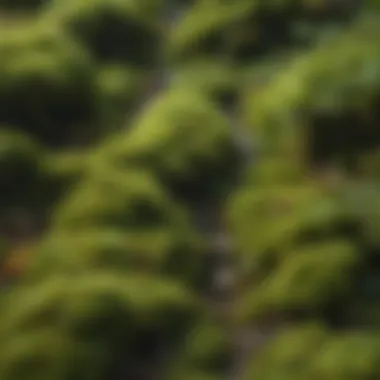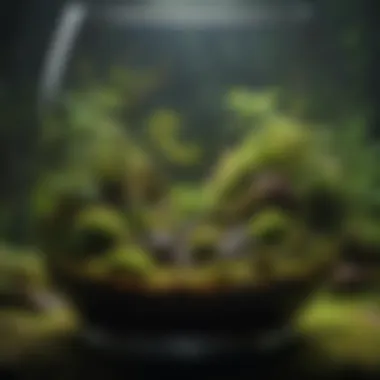The Intricacies of Mosses: Nature's Green Carpet


Intro
Mosses, often overlooked in the grand scheme of forestry and ecology, form a fascinating tapestry within woodland ecosystems. These small, unassuming plants are more than just a green carpet over the forest floor; they serve as vital players in maintaining ecological balance. Their ability to retain moisture, sequester carbon, and promote biodiversity highlights their significance, not just within forests but across various habitats. This article delves into their ecological importance, exploring their diverse varieties and the historical relevance they hold in art and conservation.
Understanding Woodland Ecosystems
Importance of Biodiversity in Forests
Biodiversity is the heart of any healthy forest. It provides the foundation upon which ecosystems thrive. Within this complex web of life, mosses play a pivotal role. By creating a microhabitat, they nurture a variety of organisms, from insects to fungi. This is essential because higher biodiversity benefits forests by making them more resilient to changes in climate and disease.
- Mosses support various life forms: They offer shelter and sustenance for numerous insects, which in turn become food for larger species.
- Facilitating nutrient cycling: Mosses enhance soil fertility by breaking down organic matter, which is crucial for the growth of surrounding vegetation.
Role of Forests in Climate Regulation
Forests are instrumental in regulating our climate. They act as carbon sinks, absorbing more carbon dioxide than they emit. This ability is heightened by mosses, which sequester carbon in their biomass while contributing to soil carbon storage through decomposition.
"Forests are the lungs of our planet, yet often, we overlook small players like mosses that significantly contribute to their health."
Sustainable management of forests can help maintain their role in climate regulation, ensuring that these green sanctuaries continue to thrive.
Sustainable Forestry Practices
Principles of Sustainable Forestry
Sustainable forestry is not merely a buzzword; it encompasses the essential practices that maintain the health of forest ecosystems while also providing for human needs. Mosses are often indicators of forest health and can guide forestry practices by indicating moisture levels and biodiversity.
- Eco-friendly logging methods: Low-impact techniques help protect moss habitats.
- Incorporating moss conservation in forestry plans: This ensures mosses continue to thrive, further enhancing the overall ecosystem health.
Case Studies of Successful Implementations
Examining successful case studies sheds light on effective sustainable measures. For instance, forest management in temperate regions has shown that preserving moss habitats leads to improved ecosystem resilience. They found that areas with robust moss communities tend to support higher levels of wildlife and healthier soil quality.
Woodland Stewardship Techniques
Forest Management Plans
A well-structured forest management plan includes provisions for preserving moss populations. Such plans must evaluate water retention and nutrient cycling capabilities. They focus on adaptive management, allowing ongoing adjustments based on monitoring outcomes.
- Monitoring changes in moss cover can inform broader ecosystem health assessments.
- Engaging local communities ensures a collaborative approach to management and conservation.
Conservation Strategies
With increasing threats from climate change and habitat destruction, moss conservation strategies have become imperative. Initiatives that promote low-impact recreation and educate the public on the importance of mosses will help garner support for conservation efforts.
- Creating awareness programs: Educational campaigns can significantly raise public consciousness about the ecological roles of mosses.
- Collaborating with researchers: Engagement with academic institutions can provide valuable data that drives effective policy changes.
Prolusion to Mosses
Mosses often get overlooked in discussions about plant life, yet their role is nothing short of crucial in both ecology and human culture. This section aims to unravel the complexities surrounding mosses, shedding light on their unique characteristics and significant ecological functions. By delving into the defining features, biological makeup, and absorption capabilities of mosses, we can appreciate their importance as more than just a lush green layer on the forest floor.
Defining Mosses
Mosses are non-vascular plants from the Bryophyta division, distinguishable from other plant types by their lack of true roots, stems, and leaves. Instead, they possess structures that play similar roles. They thrive in moist environments and are often one of the first colonizers in a given habitat, indicating a resilience that speaks to their adaptability. Understanding what mosses are is the first step in appreciating their extensive contributions to ecosystems, particularly in moisture retention and soil health.
The Biology of Mosses
Moss biology is a fascinating subject that spans various microscopic and macroscopic aspects. Each layer of their biology contributes to how they interact with their environment and play into larger ecological systems.
Cellular Structure
The cellular structure of mosses is quite unique. They are composed of simple cells that lack typical plant features like xylem or phloem. This means that mosses do not transport water and nutrients through dedicated channels, instead relying on diffusion and capillary action. This characteristic allows them to be quite versatile, as they can absorb water through their surfaces directly, enabling them to thrive in damp conditions.
One standout feature of moss cells is their protonema—the filamentous stage after spores germinate—which develops into leafy shoots. This phase is essential to moss reproduction and growth and helps them cover wide areas quickly. The simplicity of their cellular design can be viewed as both a strength and a limitation, providing resilience while lacking complexity found in higher plants.
Reproductive Strategies
Mosses have a distinctive method of reproduction that sets them apart from other plants. They reproduce both sexually and asexually, often relying on water for sperm mobility to fertilize eggs. The result is the formation of sporophytes, which release spores into the wind, allowing mosses to spread over large areas. This dual approach is beneficial, as it maximizes their chances of survival in varying environmental conditions.
One unique feature of moss reproduction is the production of gametangia, which are specialized organs that produce gametes. This strategy offers mosses flexibility, yet it also ties their reproductive success to humidity and moisture levels in their surroundings, highlighting their dependency on environmental factors.


Nutrient Absorption
Nutrient absorption in mosses occurs primarily through their leaf-like structures, a process that is highly efficient in capturing not only water but also essential nutrients from the air and surrounding environment. This method of absorption gives mosses the ability to thrive in nutrient-poor soils, making them crucial for soil stabilization.
Advantages of this absorption strategy include:
- Ability to thrive in less-than-ideal conditions.
- Contribution to soil formation and stabilization, especially in fragile ecosystems.
However, because they can specifically absorb only mineral elements available in their immediate environment, this can also be a disadvantage, limiting their growth in areas where nutrients aren't readily available.
The intimate relationship between mosses and their habitats illustrates their integral role in maintaining ecological balance, contributing not just to soil quality but also to carbon storage and moisture retention.
In summary, this exploration of mosses into their defining features, biology, and ecological strategies reveals their remarkable adaptability and essential role in a variety of ecosystems. Understanding these components lays the groundwork for further investigating their ecological significance and potential roles in conservation and environmental health.
Ecological Importance of Mosses
Mosses, despite their unassuming appearance, hold a remarkable role in the ecological balance of forest ecosystems. They are not merely green carpets blanketing the forest floor; these resilient plants contribute significantly to maintaining moisture levels, supporting biodiversity, and fostering soil stability. Understanding the multifaceted benefits that mosses provide is paramount for anyone interested in ecology and environmental stewardship.
Mosses in Forest Ecosystems
Mosses thrive in diverse forest environments, often where conditions are damp and shaded. They are known to create a microclimate that regulates temperature and humidity, making them crucial for other organisms. Their capacity to absorb and retain water helps maintain moisture levels in their surroundings, which is especially vital during dry spells. In this way, mosses not only sustain their own growth but also support the broader ecosystem.
For instance, during a particularly wet season, mosses can absorb excess rainfall, acting like a sponge. This function minimizes soil erosion, reducing the risk of landslides in hilly terrains. Conversely, when the season turns dry, this very moisture retention becomes a lifeline for other flora and fauna struggling for hydration. Mosses thus serve as guardians of the forest, contributing both to its immediate needs and its long-term vitality.
Biodiversity and Habitat Stabilization
Mosses play a pivotal role in promoting biodiversity within forest habitats. Their presence makes environments more suitable for a variety of species, leading to increased ecological stability. Both flora and fauna benefit from the unique microhabitats mosses create.
Support for Microfauna
One key aspect of mosses is their capacity to support microfauna, like tiny insects and microorganisms. These critters thrive in the moist, sheltered environment provided by mosses. They play an important role in nutrient cycling, breaking down organic matter, and enriching the soil. This symbiotic relationship underlines the interconnectedness of life in forest ecosystems. For example, beetles and springtails, which may seem insignificant at first glance, rightfully contribute to soil health as they consume decaying plant matter.
Mosses also serve as a protective haven. Many small creatures find refuge in the dense mat of moss, providing them a safe space against predators. This feature highlights why mosses are beneficial in sustaining a vibrant and diverse ecosystem.
Habitat Creation
Mosses have a unique ability to foster habitat creation within forest ecosystems. Their growth leads to the accumulation of organic material on the forest floor, which can gradually transform barren surfaces into rich soil. Over time, as mosses die and decompose, they add vital nutrients back into the soil, supporting larger plants that follow.
Furthermore, moss mats can stabilize soil in areas that are prone to erosion. As they grow, they cling tightly to the ground, helping to bind soil particles together. This characteristic is especially critical in fragile environments, such as stream banks and slopes. The stabilization provided by mosses is a long-term investment in the health and resilience of ecosystems.
In summary, the ecological importance of mosses cannot be overstated. From nurturing microfauna to creating new habitats, they are foundational to the health of forest ecosystems. The intertwining relationships forged between mosses and the various life forms they support form a delicate tapestry crucial for ecological balance.
Varieties of Mosses
When it comes to understanding the delicate tapestry of ecosystems, the varieties of mosses play a pivotal role. They not only provide a foundation for complex interactions within the plant kingdom but also for diverse organisms including insects, fungi, and even larger fauna. Each variety comes with distinct characteristics, adaptations, and ecological contributions, making them worthwhile subjects of study. By delving into both common and rare species, one can appreciate their necessity not just in nature but in human culture and conservation efforts.
Common Moss Species
Sphagnum Moss
Sphagnum moss, often found in wetlands, is renowned for its incredible water-retaining capacity. This type of moss contributes to the formation of peat, drastically aiding in carbon storage which is critical in combating climate change. One key characteristic of Sphagnum is its unique cell structure that allows it to absorb and hold large quantities of moisture—some species can hold up to twenty times their weight in water.
The distinctiveness of Sphagnum doesn't just end with its absorption; it also influences the pH and nutrient availability in the soil where it grows. For those interested in horticulture, Sphagnum moss is a beneficial choice for soil amendments and is recognized for its capability to suppress weeds. However, it can also present challenges in cultivation due to its specific growth requirements.
Polytrichum Moss
Polytrichum moss brings a different flavor to the mix, often recognized for its upright growth and dense foliage. This species is typically found in forested areas and is known for its ability to thrive in less moist conditions compared to other mosses. One notable trait of Polytrichum is its vigorous growth, making it a popular choice for creating green carpets in gardens and landscaping.
What sets Polytrichum apart is its unique feature—the peristome teeth, which help in spore dispersal. This characteristic is not only fascinating but enhances its reproductive efficiency. However, it's worth noting that while it is robust and adaptable, its dense nature can mask underlying soil issues if not properly managed.
Bryum Moss
Last but certainly not least is Bryum moss, a species that often pops up in challenging environments including rocky outcrops and urban areas. Bryum is characterized by its small leaves and forms compact mats, making it particularly resilient. This moss type is regarded as a beneficial choice for ecological landscapes due to its ability to establish itself quickly in disturbed areas, which aids in soil stabilization.
One unique feature of Bryum is its tolerance to drought, which allows it to survive prolonged periods without moisture. This adaptability comes with a downside, though; it can often be outcompeted in more humid environments, reducing its presence. Understanding the circumstances in which Bryum excels is valuable for conservation initiatives focusing on urban greening and erosion control.
Rare and Threatened Mosses
Conservation Status
The conservation status of rare and threatened mosses reveals much about our changing ecosystems. These mosses often act as barometers for environmental health, indicating shifts due to climate change, pollution, or habitat destruction. Their vulnerability can stem from specialized habitats or narrow geographic ranges, which makes them not only important for biodiversity but also for ecological resilience.


The unique characteristic of these mosses is their role in maintaining localized ecosystems. Preservation efforts based on their status can lead to broader conservation strategies that protect other species as well. Establishing a conservation status helps prioritize areas for protection, aiding not just the mosses but entire ecosystems.
Ecological Functions
Ecological functions of rare mosses extend far beyond their immediate surroundings. These mosses contribute to water retention, nutrient cycling, and habitat formation, which supports broader biodiversity. Their ability to occupy niches that other species cannot allows them to provide essential services, often underappreciated in traditional conservation discussions.
The key characteristic of rare mosses is their specialized functions within ecosystems. This includes acting as refuges for moisture-sensitive species that might otherwise struggle. By studying these ecological roles, we can better understand the cascading effects of their potential loss, not just for mosses but for entire food webs.
"The study of mosses not only enriches our understanding of plant diversity but also shines a light on the subtleties of ecological interactions that might otherwise be overlooked."
In summary, the varieties of mosses—whether common or threatened—have multifaceted roles and significance. Their contributions, while sometimes subtle, are integral to environmental health, cultural practices, and biodiversity conservation.
Growth and Habitat of Mosses
Understanding moss growth and its preferred habitats is imperative in appreciating the complexity and role mosses play within ecosystems. Mosses primarily thrive in moist environments where conditions are favorable for their survival. They contribute remarkably to the biodiversity of their surroundings and provide various ecological benefits, including soil retention and water regulation. As we explore the intricate details of their habitats and growth patterns, we gain insight into how mosses adapt and influence their ecosystems.
Preferred Environments
Moisture Requirements
Mosses have a strong affinity for moisture-laden environments. They typically require high humidity to thrive, which is a key characteristic that enables them to absorb water directly from the air through their leaves. This ability to retain moisture plays a significant role in regulating local climates and supports surrounding vegetation. In fact, areas rich in moss cover often experience improved humidity levels which can foster an enriched microenvironment.
Unique features of moisture requirements in mosses also include:
- Capillary Action: Mosses can retain water through capillary action, allowing them to stay hydrated in otherwise dry conditions.
- Lack of Vascular System: Their non-vascular nature means mosses don't have specialized tissues to transport water. Rather, they depend on direct absorption, which exposes them to both advantages and limitations depending on their habitat.
The disadvantages include vulnerability to drought; once the soil moisture diminishes, mosses can dry out rapidly and may take time to recover. Such characteristics, however, make them key indicators of ecosystem health.
Light Conditions
Mosses generally prefer shaded environments but can adapt to various light conditions. Under the canopy of trees, they receive filtered sunlight, which is crucial for photosynthesis without the risk of drying out. Their ability to thrive in low-light situations is a critical feature that makes them incredibly resilient.
Benefits of light conditions for mosses include:
- Shade Tolerance: They can grow in dense forested areas where sunlight is sparse, competing effectively with other plant species for survival.
- Growth Rate: Given the right light conditions, mosses can proliferate rapidly, covering vast areas and enhancing soil structure.
However, while they do adapt to different light levels, direct sunlight can often lead to desiccation. High light intensities might not only hinder their growth but can cause damage to their tissues, further complicating their survival in exposed environments.
Moss Growth Patterns
Moss growth patterns are fascinating and reveal much about their survival strategies. The ways in which they colonize areas and adapt seasonally demonstrate their resilience and ecological importance.
Colonization Mechanisms
Mosses rely on several unique colonization mechanisms that contribute to their ability to spread across diverse environments. They usually propagate through spores or vegetative fragments, ensuring their presence in various habitats. This versatility is instrumental in maintaining ecosystem stability as mosses often act as pioneer species in barren areas.
Key characteristics of their colonization include:
- Spore Dispersal: Lightweight spores can travel great distances, often via wind or water, allowing mosses to reach new locations easily.
- Fragmentation: Small pieces of moss can regenerate into new plants, giving them a sort of second life if parts get broken off.
Challenges do arise as colonization can be limited by certain harsh conditions like extreme soil temperatures or droughts which may impact successful reproduction.
Seasonal Variations
Mosses exhibit distinct growth patterns that vary with the seasons, which profoundly influences their life cycle. They respond to climatic changes with remarkable adaptability. In springtime, with the arrival of increased moisture and warmth, many moss species multiply and flourish. Conversely, cold weather can lead to dormancy as they slow down metabolic activities to conserve water and energy.
Some unique features of seasonal growth include:
- Dormancy: In harsher winters, mosses can enter a dormant phase, enabling them to withstand periods of extreme weather without death.
- Revitalization: As temperatures rise, mosses quickly rehydrate and resume growth, showcasing their resilience.
Yet, seasonal changes can also restrict growth; prolonged droughts or freezing temperatures can stunt development or lead to die-off in susceptible species.
Understanding the intricacies of mosses—especially their growth and habitat requirements—not only sheds light on their ecological roles but also emphasizes the urgent need for conservation efforts aimed at preserving these vital organisms in our changing world.
Moss Utilization in Human Culture
Mosses have long been a silent yet significant player in the story of human culture, weaving through history and innovation. Their roles, beyond just being a simple green carpet in the wild, stretch into the realms of tradition, art, and even modern design principles. By understanding how humans have harnessed moss over the centuries, we gain deeper insight into cultural expressions and environmental consciousness.
Historical Perspectives
From ancient times, mosses have been used for various practical purposes. In Europe, they were often employed as bedding for the sick, due to their softness and ability to retain moisture. Such characteristics made them ideal for creating a comfortable resting place, especially in times when resources were scarce. Coast-to-coast, indigenous cultures utilized peat moss as insulation in their dwellings. This natural material helped retain heat during chilly nights, showcasing a remarkable relationship between people and the natural world.


Moss also features prominently in traditional crafts and practices. For example, Japanese culture has deep-rooted connections with moss through the establishment of moss gardens known as "koke-dana." These gardens, meticulously designed, symbolize tranquility and a return to nature, offering a respite for meditation and reflection. This speaks to how mosses have transcended their ecological role and echoed spiritual sentiments in many societies.
Artistic Applications
Traditional Crafts
Traditional crafts employing moss highlight its versatility and natural beauty. For instance, using moss in flower arrangements brings a unique lushness that cannot be replicated by synthetic materials. This natural element not only enhances aesthetics but also embodies a commitment to sustainable practices. Artists and crafters appreciate that moss is widely available and can be harvested without significant environmental impact, making it a popular choice in creating decorations, wreaths, and even festive displays.
The key characteristic of using moss in traditional crafts is its ability to blend harmoniously with other organic materials, allowing for stunning visual contrasts. This adaptability makes moss a central player in various craft traditions. Moreover, it is relatively low maintenance compared to other natural materials, enhancing its appeal among artisans.
"Crafting with moss connects us back to the earth, and provides a tactile experience unlike any other material."
While the advantages of incorporating moss are many, some challenges exist as well. Moss can dry out quickly without proper care, and different species may require specific conditions to thrive. Thus, knowledge of moss varieties is crucial for successful crafting.
Modern Aesthetics
In contemporary design, moss has found its way into interior spaces, becoming an emblem of eco-friendly decor. Living walls featuring moss not only introduce greenery into urban environments but also improve air quality. Homeowners increasingly favor this organic element for its low maintenance and ability to flourish in lower light conditions. The unique feature of moss installations is their adaptability to various settings, from urban flats to modern offices.
The predominant characteristic of modern aesthetics involving moss is its ability to evoke a connection to nature, even in sterile environments. This aspect resonates in urban dwellings where space is limited and outdoor access may be restricted. However, one must consider the balance between design and ecological consequences; sourcing moss sustainably and maintaining its health is paramount.
In summary, mosses serve a dual purpose, nurtured by both tradition and innovation. Through historical practices to contemporary artistic expressions, they exemplify a rich tapestry of human culture interwoven with the natural world. Understanding their multifaceted role opens up dialogues about environmental stewardship, creativity, and the timeless bond humans share with nature.
Moss and Environmental Stewardship
Mosses, often overlooked in discussions about ecological conservation, play a vital role in environmental stewardship. These quiet yet resilient organisms act as indicators of ecosystem health, bridging the gap between flora and fauna within diverse habitats. Their simple appearance belies a complexity that is both remarkable and beneficial, highlighting why they deserve attention in discussions of conservation efforts.
Mosses as Indicators of Ecosystem Health
Mosses are not just a pretty carpet covering the forest floor; they serve as excellent bioindicators of environmental quality. Their presence, absence, or abundance can hint at the condition of the ecosystem surrounding them. For instance, sensitive species like Polytrichum have a high intolerance to pollution, while others may thrive in clean environments. Monitoring moss populations can provide insights into soil acidity, moisture levels, and even air quality.
The ability of mosses to absorb moisture can also be a telling sign. A thriving population often signals a balanced ecosystem, maintaining vital moisture levels that support other organisms. Conversely, declining moss growth might indicate deteriorating habitat conditions, prompting further investigation into the potential sources of ecological stress.
"Mosses are essential indicators of nature's pulse in an ever-changing environment, reflecting both environmental changes and the health of our planet."
Conservation Efforts for Moss Habitats
Protecting Native Species
The notion of protecting native species focuses on preserving the unique moss varieties that define ecosystems. Native mosses are fine-tuned to their environments, forming symbiotic relationships with surrounding plants and animals. Ensuring their survival fosters resilience against invasive species and ecological alterations. Understanding the specific habitat requirements of native mosses, such as moisture levels and sunlight, is crucial. If their habitat is altered, whether from logging, urban development, or climate change, the biodiversity of the entire ecosystem could falter.
One key characteristic that makes protecting native species essential is their role in carbon sequestration. Mosses are remarkable carbon sinks, playing a significant role in climate change mitigation. By safeguarding their habitats, we harness their natural ability to capture and store carbon, contributing to overall ecological stability.
Restoration Projects
Restoration projects for moss habitats often involve a multi-faceted approach focused on reviving damaged ecosystems. One major aspect includes reintroducing native moss species that may have been displaced or entirely eliminated. It’s not just about planting moss; ensuring the conditions are suitable for growth is also critical.
A unique feature of restoration efforts is the ability to improve soil health through moss revitalization. Many moss varieties enhance soil structure by holding nutrients and moisture, facilitating the growth of other plants. This method not only aids in repairing damaged ecosystems but enhances their resilience against future disturbances.
While these restoration projects provide many benefits, they can also face challenges. The reintroduction of moss requires careful planning and monitoring, as not all species adapt quickly to transplantation. A delicate balance must be struck between intervention and allowing natural processes to guide rejuvenation efforts.
Future Research Directions in Moss Studies
The exploration of mosses extends beyond their current ecological and cultural significance. Future research in this area holds promise for unveiling even more about their role within ecosystems and humans' relationship with nature. Understanding mosses better can lead to innovative solutions for conservation and environmental management. There’s a whole world left to discover, and this section aims to provide insight into exciting upcoming themes in moss research.
Innovative Technologies in Moss Research
The integration of innovative technologies in moss research can transform how we study and utilize these organisms. Recent developments in imaging and molecular biology allow researchers to observe moss growth patterns and cellular processes with greater precision. For example, advancements in microscopy help scientists to visualize the complex structures in moss cells that were once too small to see under traditional methods.
More importantly, the use of remote sensing technologies can assist in mapping moss distribution across various terrains. These insights not only help in understanding moss habitats, but they can also aid in preserving those environments. By gauging the health of moss populations through satellite imagery, conservationists can take proactive steps to ensure that these vital ecosystems flourish.
Interdisciplinary Collaborations
Ecology and Biotechnology
The intersection of ecology and biotechnology presents fertile ground for advancing our understanding of mosses. Researchers harness biotechnological tools to explore the genetic makeup of various moss species. This genetic insight can reveal mosses' resilience to climate change and their adaptations to different environments. A key characteristic of this collaboration is the application of CRISPR gene-editing technology, which can help in promoting desired traits in mosses for restoration projects.
This approach not only helps in conservation efforts but also bridges gaps between different scientific disciplines. The unique feature of combining ecological studies with biotechnology is that it enables targeted research which can lead to increased efficiency in restoration projects. While benefits are plentiful, it's also wise to consider the ethical implications of genetically modifying organisms in their natural habitats.
Public Health and Urban Planning
In exploring the relationship between public health, urban planning, and mosses, researchers have begun to realize that mosses can contribute to better urban environments. For instance, incorporating mosses into green roofs can improve air quality and reduce urban heat islands. This aspect of urban planning highlights the sustainability of using natural elements in architecture and landscape design, making it a popular choice for modern city planners.
Furthermore, mosses can act as bioindicators of environmental quality; they absorb heavy metals and pollutants from the air. Their presence or absence in urban settings may inform public health policies, steering discussions on environmental regulations. This unique feature of mosses allows them to serve as both a decorative component in cityscapes and a functional element of ecological monitoring. However, urban planners must be informed about the specific types of mosses suitable for city conditions, along with their maintenance requirements, to ensure a successful integration.
"Mosses are like the Earth's own sponges; their ability to retain moisture and absorb pollutants makes them essential assets in promoting sustainable, healthier urban environments."
This section outlines crucial future directions of moss studies, emphasizing interdisciplinary collaboration and innovative technologies that can lead to groundbreaking discoveries. With a focus on practical applications in ecology and urban settings, the ongoing research surrounding mosses promises to broaden our understanding of these subtle yet vital organisms across the globe.







